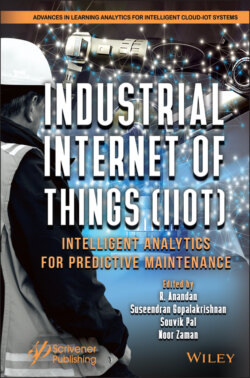Читать книгу Industrial Internet of Things (IIoT) - Группа авторов - Страница 17
1.3 IoT Ecosystem
ОглавлениеIoT is basically things, i.e., it is all types of equipment/device/sensor that can be connected in different ways, from a truck to monitor the displacement of product transport fleets, use of sensors in tractors that measure the soil situation and send data to systems responsible for processing this information, and make suggestions for the best areas or times for planting, a boiler temperature sensor in a factory, or the adoption of devices at home, such as thermometers, energy consumption regulators, or home appliance managers, who allow the householder to control this equipment remotely, or even microsensors that monitor the status of patients remotely in hospitals or outside them [45].
In IoT, it is consistent with an environment whose rules deal with both connection and intelligent data collection and processing, since applications allow the coordinated and intelligent use of devices to control various activities, from monitoring with cameras and sensors to managing spaces and of productive processes. The IoT ecosystem is a system composed of a digital space of interaction including digital tools related to data analysis and modeling, as well as digital elements that integrate and interact within it. It is through these interactions and the exchange of information that AI allows these elements to work in an integrated manner, composing an intelligence potential far superior to what each of its elements has separately. The IoT ecosystem involves different agents and processes, such as smart objects [sensors, appliances, cars (Figure 1.9), and factory automation equipment], smart modules (processors and memories), connectivity services (access to the internet or private networks that connect these devices), integrators (systems that combine applications, processes, and devices), enablers (control systems, collection, and processing of data and commands involving objects), and even providers of IoT services [45, 46].
Figure 1.9 Maintenance IoT vehicle illustration.
Within an IoT ecosystem, applications that integrate IoT technologies with Big Data technologies are operated, enabling the collection and analysis in real time of large data sets, allowing the development of predictive models for a variety of situations, from consumer behavior to the prevention of factory failures, and optimizing activities on the most varied fronts of activity. IoT technology brings changes both in the development of more pervasive connectivity and in the increase of data processing, derived from the refinement of sensors that allow data collection in different environments. All of this is associated with some practical solution allowing for increased efficiency, reduced human intervention, or even new business models [45], still evaluating that the AI generates a layer to enhance the value generated by the analysis of the different information captured and combined; allowing the automation of the decision-making process and actions in specific situations; bringing significant benefits to the increase in the speed of processes, reduction of the error rate due to human interference, and reduction of costs per transaction, in addition to the possibility of greater absorption of insights at each interaction that feedback and “teach” the AI algorithms (Machine Learning as an example); and making this incrementally more efficient [31].
In the digital transformation of the industry (relating the advent of the Fourth Industrial revolution), AI associates IoT with the combination of the ecosystem for data transmission between devices and the technology for analyzing this information independently, still conceptualizing the emergence of Artificial Intelligence of Things (AIoT). Considering that the IoT concept is related to the various IoT devices that collect data and create a network for transmitting critical information to administrators, on the other hand, AIoT data is processed by resources that analyze the standards providing only the information necessary for making a decision and can even make the necessary decisions without human involvement [17].
Pondering on AI, this uses algorithms to analyze data and resources through aspects such as Machine Learning by automating processes without manual intervention, incorporating with IoT gaining connectivity and capacity for data exchange. The great advantage of the IoT concept is in the various solutions involving machine-to-machine communication, integrated into a single network, where it publish and consume information. Thus, it is through the integration of IoT, with the analysis of broad data sets (Big Data Analytics), and with the performance in ecosystems using AIoT that it is possible to exceed the limits that each of these technologies has individually, developing an advanced solution to support operational management, offering predictive maintenance, and consequently increasing control, quality, and efficiency in business operations [35].
